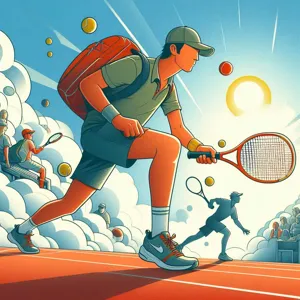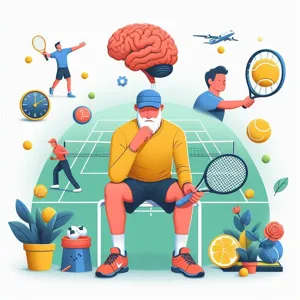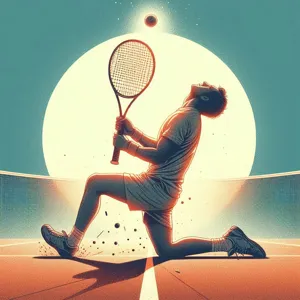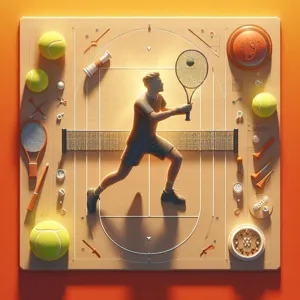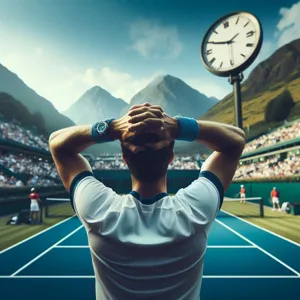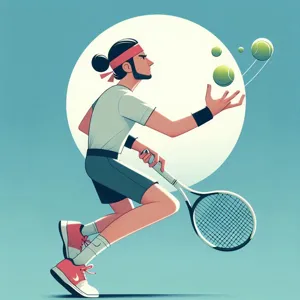Tennis is not just a test of skill; it’s a battle of mental fortitude, especially when the stakes are high.
Whether you’re facing match point in a local tournament or a crucial serve during a friendly competition, the pressure can feel overwhelming. This blog post, “Mastering the Moment: Tips to Enhance Your Tennis Game Under Pressure,” is designed for players of all levels who want to transform anxiety into confidence on the court. We’ll explore effective strategies to help you harness your mental strength, improve focus, and maintain composure when it matters most. From breathing techniques to visualization exercises, these practical tips will empower you to turn tense situations into opportunities for greatness. Join us as we dive into the art of mastering the moment and elevate your game to new heights!
1. Understanding Pressure in Tennis

Understanding pressure in tennis is crucial for elevating your game, especially when the stakes are high. Pressure can manifest in various forms—be it the anticipation of a crucial match point, the weight of a championship title, or the expectations of your coaches and fans. It’s that heightened state of awareness that can either propel you to peak performance or cause your skills to falter.
In tennis, pressure often feels like an invisible opponent, lurking behind every serve and volley. The sound of the crowd, the tension in the air, and the ticking clock can combine to create an overwhelming environment. Recognizing how pressure affects you personally is the first step in mastering it. Some players thrive under pressure, finding an adrenaline rush that sharpens their focus and enhances their performance, while others may experience anxiety that leads to mistakes and missed opportunities.
Understanding the physiological and psychological responses to pressure is vital. Your heart rate may increase, your palms may sweat, and thoughts may race, potentially leading to self-doubt. It’s essential to acknowledge these feelings without letting them overtake your game. By developing awareness of how pressure impacts your mindset and body, you can implement strategies to manage it effectively.
Additionally, consider how pressure influences your decision-making on the court. Under duress, players may revert to instinctive, less strategic choices rather than the well-thought-out tactics they’ve practiced. This is where mental training techniques—such as visualization, breathing exercises, and positive self-talk—become invaluable tools for maintaining composure.
Ultimately, understanding pressure in tennis means embracing it as an integral part of the game. The more familiar you become with its nuances, the better prepared you’ll be to harness its energy to boost your performance when it matters most. Embrace the challenge, learn from each experience, and transform pressure into a powerful ally on your path to tennis mastery.
2. The Mental Game: Building a Strong Mindset
In the world of tennis, where matches can pivot on a single point, the mental game is just as crucial as physical prowess. Building a strong mindset is not merely about maintaining focus; it’s about cultivating resilience, confidence, and the ability to thrive under pressure. A robust mental framework enables players to navigate the highs and lows of competition, ensuring that anxiety doesn’t overshadow their skills during pivotal moments.
To start, visualization techniques can be incredibly beneficial. Picture yourself in high-pressure scenarios, such as serving for the match or facing a break point. Imagine executing your shots flawlessly and savoring the thrill of victory. This mental rehearsal not only prepares you for real match situations but also instills a sense of confidence that you can draw upon when the stakes are high.
Another vital component is the practice of mindfulness. By centering your thoughts and focusing on the present moment, you can reduce performance anxiety and enhance concentration. Techniques such as deep breathing or meditation can help clear your mind, allowing you to approach each point with clarity and calmness. Remember, a relaxed mind is more agile and responsive, making it easier to adapt to your opponent’s strategy and the ebb and flow of the game.
Additionally, developing a positive self-talk routine can significantly impact your performance. Replace negative thoughts with affirmations that reinforce your capabilities. Phrases like “I am prepared,” “I can handle this,” or “I thrive under pressure” can create a compelling narrative in your mind, transforming doubt into determination.
Lastly, embracing failures as learning opportunities is key to strengthening your mental resilience. Every player encounters setbacks; it’s how you respond to them that can define your journey. Instead of dwelling on mistakes, analyze what went wrong, adjust your approach, and move forward. This growth mindset will not only enhance your performance but also transform your overall experience on the court.
Mastering the mental game equips you with the tools to face challenges head-on, ensuring that when the pressure mounts, you remain focused, confident, and ready to seize the moment.
3. Visualization Techniques for Success

Visualization techniques are a powerful tool in the athlete’s arsenal, especially in high-pressure situations like a tennis match. By mentally rehearsing your strokes, footwork, and strategies, you can create a vivid blueprint of success in your mind, which can significantly enhance your performance on the court.
Begin by finding a quiet space where you can focus without distractions. Close your eyes and take a few deep breaths to calm your mind. Visualize yourself standing on the court, feeling the sun warming your skin and the grip of your racket in your hand. See yourself executing your favorite shots—whether it’s a powerful serve that rockets over the net or a deft drop shot that dances just inside the baseline. Imagine the sound of the ball hitting the strings and the satisfying thud as it lands precisely where you intended.
As you deepen this visualization, incorporate the emotions tied to these successful moments. Feel the rush of adrenaline as you ace your opponent or the sense of calm that washes over you when you maintain your composure during a tense rally. By vividly imagining these scenarios, you condition your mind to respond positively when you encounter similar situations in real matches.
Additionally, consider visualizing the pressure moments that tend to trip you up. Imagine yourself facing a challenging point, perhaps in a crucial game. Picture how you will react: maintaining your breath, focusing on your technique, and executing your plan. This mental rehearsal helps to build confidence, making it easier to perform under pressure when it truly counts.
By consistently practicing visualization techniques, you not only improve your mental resilience but also create a strong connection between your mind and body. This synergy is essential for mastering the moment in tennis, allowing you to stay composed and focused, even when the stakes are high. In tennis, where every point can shift the momentum of the match, being mentally prepared can make all the difference.
4. Breathing Exercises to Stay Calm
In the high-stakes world of tennis, where each point can feel like a make-or-break moment, mastering the art of staying calm under pressure is crucial. One of the most effective ways to achieve this is through the practice of breathing exercises. These techniques, often overlooked in the heat of competition, can serve as your secret weapon to maintain focus, reduce anxiety, and enhance overall performance.
When the adrenaline starts pumping and the crowd’s cheers become a distant roar, taking a few deep breaths can ground you. Consider incorporating a simple technique known as “box breathing.” This method involves inhaling deeply through your nose for a count of four, holding that breath for another four counts, exhaling slowly through your mouth for four counts, and finally holding your breath again for four counts before repeating the cycle. This rhythmic pattern not only calms your mind but also helps regulate your heart rate, allowing you to regain control of your emotions on the court.
Another beneficial practice is visualization combined with breathing. As you take deep, measured breaths, picture yourself executing successful shots, moving fluidly across the court, and handling pressure with grace. This mental imagery reinforces your confidence and prepares your body to react instinctively when the stakes are high.
Incorporating these breathing exercises into your pre-match routine and during changeovers can create a powerful buffer against the intensity of competition. Not only will they help you stay calm, but they will also enhance your focus, allowing you to make strategic decisions rather than reactive ones. Remember, in tennis, as in life, it’s not just about the physicality of the game; it’s also about the mental fortitude you bring to every moment. By mastering the art of breathing, you can transform pressure into an opportunity to shine.
5. Developing a Pre-Serve Routine
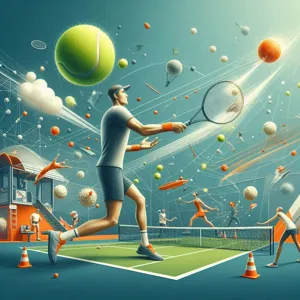
A well-crafted pre-serve routine can be your secret weapon when the pressure mounts during a match. Just as a musician warms up before a performance, a consistent routine allows you to find focus and rhythm in the chaos of competition. This ritual doesn’t have to be elaborate; it simply needs to resonate with you and help you settle into the moment.
Begin by identifying the steps that make you feel most comfortable and confident. Some players prefer to bounce the ball a specific number of times, while others might take a deep breath to center their thoughts. You might incorporate a few dynamic stretches or a mental visualization of your ideal serve trajectory. The key is to create a sequence that calms your nerves and prepares your body for action.
As you develop your routine, practice it diligently during training sessions. Repetition will not only solidify the routine in your muscle memory but also instill a sense of familiarity that can be incredibly reassuring in high-stakes situations. When you step up to serve, this routine should become your sanctuary—a moment to block out distractions and focus on the task at hand.
Furthermore, consider incorporating an element of mindfulness into your pre-serve routine. As you go through your motions, take a moment to acknowledge the pressure, then consciously release it. This mental reset can be transformative, allowing you to approach each serve as an opportunity rather than a threat. By mastering your pre-serve routine, you’ll enhance your ability to perform under pressure, transforming anxiety into precision and confidence on the court.
6. Emphasizing Focus and Concentration
In the high-stakes world of tennis, where every point can sway the match in either direction, maintaining focus and concentration becomes your secret weapon. It’s all too easy to let the pressure of the moment cloud your judgment or distract you from your game plan. To enhance your performance under pressure, you must cultivate a mental discipline that sharpens your awareness and fortifies your resolve.
Begin by establishing a pre-serve routine—a sequence of actions that grounds you before each point. This could include a few deep breaths, visualizing the shot you want to execute, or even a quick mental check-in to remind yourself of your strategy. This ritual serves as a mental anchor, helping you block out distractions and redirect your energy toward the upcoming challenge.
Additionally, consider practicing mindfulness techniques. Spend time off the court engaging in meditation or focused breathing exercises, which can help train your mind to remain present and calm during intense moments. When you find yourself feeling overwhelmed, take a moment to reset: focus on your breath, observe your surroundings, and remind yourself that the match is a series of individual points rather than a daunting whole.
Moreover, challenge yourself in practice by simulating high-pressure scenarios. Whether it’s setting up a tie-break situation or playing against a friend with a competitive edge, these drills can help you learn to manage your emotions and maintain composure when the stakes are high. By exposing yourself to pressure in practice, you’ll develop the resilience needed to thrive in actual match situations.
Ultimately, cultivating focus and concentration is about training your mind as rigorously as you train your body. With practice, you’ll find that you can harness the pressure to elevate your game rather than let it hinder your performance. Embrace the challenge, refine your mental approach, and prepare to master those pivotal moments on the court.
7. Strategies for Staying Positive During Matches

In the high-stakes world of tennis, maintaining a positive mindset during matches can be just as crucial as your physical skills. Pressure can manifest in many forms—whether it’s the roaring crowd, a fierce opponent, or the weight of expectation. How you handle these moments can make or break your performance. Here are some effective strategies to cultivate positivity and mental resilience when the going gets tough.
**1. Focus on the Process:** Rather than fixating on the score or outcome, divert your attention to the fundamentals of your game. Concentrate on your footwork, your service motion, or your follow-through. By zeroing in on the process rather than the result, you can diminish anxiety and redirect your energy into executing your skills.
**2. Use Positive Self-Talk:** The way you talk to yourself can significantly impact your mental state. Replace negative thoughts with affirmations that boost your confidence. Phrases like “I am strong” or “I can do this” can help shift your mindset from doubt to determination. Practicing this self-talk during practice sessions can make it more natural when faced with pressure in a match.
**3. Visualization Techniques:** Before stepping onto the court, take a moment to visualize your ideal performance. Imagine yourself executing your shots flawlessly, maintaining your composure, and overcoming challenges. Visualization can prepare your mind for success and help you stay relaxed and focused during crucial moments.
**4. Embrace the Challenge:** Instead of viewing pressure as a burden, see it as an opportunity for growth. Acknowledge the challenge, but remind yourself that every match is a chance to improve and learn. This shift in perspective can transform anxiety into excitement, fueling your determination to rise to the occasion.
**5. Build a Support System:** Surround yourself with positive influences, whether it’s coaches, teammates, or family members. Their encouragement can serve as a powerful reminder of your capabilities, especially during tense moments. Consider establishing a routine where you check in with a trusted supporter before matches to boost your morale.
**6. Practice Mindfulness:** Incorporating mindfulness practices, such as deep breathing or meditation, can help you stay grounded in the moment. When you feel stress creeping in, take a few deep breaths, focusing on the rhythm of your inhalations and exhalations. This simple practice can clear your mind, reduce anxiety, and help you regain focus.
By implementing these strategies, you’ll not only enhance your ability to stay positive during matches but also cultivate a mindset that thrives under pressure. Remember, tennis is as much a mental game as it is a physical one, and mastering your mindset can lead to breakthroughs in your performance on the court.
8. Handling Expectations: Yours and Others’
In the high-stakes world of tennis, the pressure to perform can be overwhelming. Whether you’re competing in a local tournament or aiming for a championship title, the expectations you set for yourself, along with those imposed by coaches, family, and friends, can weigh heavily on your shoulders. Learning to navigate these expectations is crucial for enhancing your game under pressure.
First and foremost, it’s essential to establish realistic goals that align with your current skill level and circumstances. While ambition drives improvement, setting unattainable expectations can lead to frustration and anxiety. Instead of fixating on winning every match, focus on specific aspects of your game that you want to improve—be it your serve accuracy or your ability to stay calm during crucial points. This shift in perspective allows you to channel your energy toward personal growth rather than external validation.
Equally important is understanding the expectations of those around you. Friends and family may mean well, cheering you on with high hopes, but their enthusiasm can inadvertently add to your stress. Communicate openly with them about how their expectations affect you. Let them know that while their support is invaluable, you thrive when you can play freely without the burden of pressure. This dialogue not only helps manage their expectations but also fosters a supportive environment where you can focus on your performance.
Additionally, practice mindfulness techniques to help you cope with the intensity of expectations. Techniques like deep breathing, visualization, and positive affirmations can ground you in the moment, allowing you to focus on your game rather than the outcome. When you feel that familiar pressure creeping in, take a step back, breathe deeply, and remind yourself of your dedication and hard work. By cultivating a mindset that views each game as an opportunity for growth rather than a test of worth, you’ll find yourself more resilient and better equipped to handle the heat of competition.
Ultimately, mastering the moment in tennis isn’t just about skill; it’s about managing the expectations that come with the game. By setting realistic goals, communicating openly with your support system, and practicing mindfulness, you can transform pressure into a powerful motivator, allowing your true potential to shine through when it matters most.
9. Practicing Under Pressure: Simulation Drills
Practicing under pressure is an essential component of improving your tennis game, especially when the stakes are high. Simulation drills are designed to replicate the stress and intensity of match play, allowing you to develop the mental resilience needed to perform at your best when it truly matters.
Start by setting up scenarios that mimic critical moments in a match. For instance, create a drill where you play a set tiebreaker against a partner, with each point counting as if it were a match point. This will help you acclimate to the feeling of being on the brink of victory or defeat. Alternatively, you can simulate a high-pressure situation by playing with a score disadvantage—forcing yourself to come back from behind.
Incorporate time constraints into your drills as well. For example, set a timer to complete a certain number of points or games, which will push you to make quick decisions and maintain focus under pressure. Another effective method is to practice with distractions, such as noise or an audience, to mirror the environment of a competitive match.
Lastly, consider adding a mental component to your practice. After every drill, take a moment to reflect on how you handled the pressure. What thoughts crept in? Did you maintain your composure? This reflection will not only enhance your self-awareness but also equip you with strategies to manage pressure in real matches. By consistently incorporating these simulation drills into your training routine, you’ll build confidence and mental fortitude, ensuring that you can master the moment when it counts the most.
10. The Role of Physical Fitness in Stress Management
In the high-stakes world of tennis, physical fitness plays a pivotal role not only in your performance but also in how you manage stress on the court. When the pressure mounts—whether it’s during a crucial match point or a tense tiebreaker—being in peak physical condition can be your secret weapon. A well-conditioned body enhances your stamina, agility, and strength, allowing you to execute your shots with precision while maintaining your composure.
Regular cardiovascular training, such as running or cycling, builds endurance, ensuring you can sustain high levels of energy throughout long matches. Strength training not only improves your power on the court but also fortifies your muscles against injuries, which can be a source of stress if you’re worried about physical setbacks. Moreover, flexibility exercises, like yoga or dynamic stretching, enhance your range of motion, enabling you to recover quickly from unexpected movements and maintain control under pressure.
Beyond the physical benefits, a strong fitness regimen contributes to mental resilience. Exercise releases endorphins, the body’s natural stress relievers, which can help you stay calm and focused even in the most challenging situations. When your body feels strong and capable, your confidence skyrockets, allowing you to tackle pressure head-on rather than shying away from it.
Incorporating fitness into your training routine doesn’t just prepare you for the physical demands of the game; it also equips you with the mental fortitude needed to thrive when it matters most. So, lace up those sneakers, hit the gym, and embrace the workout regime that will not only enhance your game but also transform how you handle pressure on the court.
11. Learning from Mistakes: Embracing Failure
In the high-stakes world of tennis, where every point can feel like a life-or-death situation, the pressure to perform can be overwhelming. However, one of the most powerful tools at your disposal is learning from your mistakes. Embracing failure is not just about acknowledging when things go wrong; it’s about transforming those moments into invaluable lessons that can elevate your game to new heights.
Every tennis player, no matter how seasoned, has faced the sting of defeat—whether it’s a double fault at a critical moment, a missed opportunity to win a set, or a match that slips away against a rival. Instead of allowing these experiences to haunt you, approach them as essential stepping stones on your path to mastery. After each match, take the time to reflect on your performance. What worked well? What didn’t? Were there patterns in your play that led to mistakes?
Consider keeping a journal where you can document these reflections. Write down specific instances where pressure impacted your decision-making or execution. This practice not only helps you identify weaknesses but also allows you to create strategies for improvement. For example, if you notice that you tend to rush your serves when the score is tight, use your next practice sessions to focus on rhythm and timing under pressure.
Additionally, seek feedback from coaches or peers. They can offer fresh perspectives on your performance and help you see mistakes in a new light. Remember, every great player has faced setbacks; what sets them apart is their ability to learn and adapt. Embracing failure as a natural part of the journey will not only bolster your resilience but also sharpen your skills, giving you the confidence to face future challenges with a clear mind and a determined spirit. Ultimately, mastering the moment means understanding that each mistake is a lesson, and with each lesson learned, you’re one step closer to becoming the player you aspire to be.
12. In-Match Adjustments: Adapting to Changing Situations
In the dynamic world of tennis, the ability to adapt during a match is often what separates the good players from the great ones. Every point can present a new challenge, and the conditions can shift in the blink of an eye—whether it’s a sudden gust of wind, an opponent’s unexpected strategy, or even a shift in your own mental state. Mastering in-match adjustments is crucial for enhancing your game under pressure.
Start by honing your awareness on the court. This means not just focusing on the ball, but also observing your opponent’s tendencies—are they favoring their forehand? Struggling with backhand returns? Identifying these patterns early allows you to make targeted adjustments. For instance, if you notice your opponent is consistently missing wide on their backhand, you might exploit this by directing your shots to that side more often.
Additionally, don’t shy away from altering your playing style as the match progresses. If you’re initially aggressive but find that your opponent thrives on pace, consider dialing back and focusing on placement rather than power. Implementing a more strategic approach can disrupt your opponent’s rhythm and give you the upper hand.
Another critical aspect of in-match adjustments is your mental approach. Stay calm and composed, even when the match isn’t going in your favor. Take a moment between points to reset your mind, breathe deeply, and visualize your next successful shot. This mental clarity can help you make better decisions and maintain focus, which is essential when the stakes are high.
Finally, communicate with your coach or support team during changeovers. They can provide valuable insights that you might not see in the heat of the moment. Whether it’s a quick reminder of your game plan or a nudge to focus on your strengths, having an external perspective can bolster your confidence and guide your adjustments.
In conclusion, the ability to make in-match adjustments is a vital skill for any tennis player looking to enhance their game under pressure. By staying aware, being flexible in your strategy, maintaining mental composure, and seeking external feedback, you can navigate the ever-changing landscape of a match and put yourself in the best position to succeed.
13. The Importance of Post-Match Reflection
Post-match reflection is a crucial component of any athlete’s growth, yet it is often overlooked amidst the adrenaline and excitement of competition. Taking the time to assess your performance after a match can be the key to unlocking your full potential on the court. This process allows players to analyze not only the technical aspects of their game but also the emotional and psychological factors that influenced their performance.
After the final point has been played, consider setting aside a few quiet moments for introspection. Reflect on your decision-making during critical points—were you too aggressive, or did you play it too safe? Analyze your shot selection and footwork: were you positioned correctly, and did you execute your strokes with precision? It’s equally important to evaluate your mental state throughout the match. Did you maintain focus, or were there moments when frustration or doubt crept in?
Journaling these reflections can be particularly beneficial. Write down your observations while the match is still fresh in your mind, noting both the positives and areas for improvement. This practice not only solidifies lessons learned but also tracks your progress over time. By identifying patterns in your performance, you can create targeted training sessions that address specific weaknesses.
Additionally, consider discussing your reflections with a coach or trusted teammate. They can provide valuable insights and alternative perspectives, helping you to see aspects of your game that you may have missed. This collaborative approach fosters an environment of continuous learning and improvement.
Incorporating post-match reflection into your routine not only enhances your technical skills but also builds mental resilience. As you become more adept at evaluating your performances, you’ll find that you can better manage pressure in future matches. Ultimately, this habit sets the stage for consistent growth, helping you to master the moments that matter most on the court.
14. Finding Your Flow: Getting in the Zone
Finding your flow—often referred to as “getting in the zone”—is a magical state where everything clicks, and your mind and body become perfectly synchronized. In tennis, this is essential, especially during high-stakes matches where the pressure can be overwhelming. Achieving this state requires practice, patience, and a few strategies that can help you tap into your peak performance.
To start, create a pre-match routine that helps calm your nerves and focus your mind. This could include deep breathing exercises, visualization techniques, or even listening to your favorite music to elevate your mood. The key is to find what works for you and stick with it, as consistency breeds familiarity, allowing you to enter your flow state more easily when it counts.
During matches, pay attention to your body language and mental state. Champions often describe a sense of detachment from the outcome, allowing them to play freely without the burden of expectation. This involves embracing the present moment and concentrating solely on each point rather than the match score or future implications. Techniques such as mindfulness meditation can be particularly effective in training your mind to stay in the moment.
Finally, don’t underestimate the power of rhythm in your game. Developing a routine for your serves and shots can create a comfortable cadence that may help you slip into that flow state. Whether it’s bouncing the ball a certain number of times before serving or using a specific rhythm in your footwork, these small rituals can provide a sense of control amidst the chaos of competition.
By mastering the art of getting in the zone, you can elevate your tennis game, enabling you to perform at your best, even under the most intense pressure. Embrace the flow, and watch as your confidence and performance soar on the court.
15. Conclusion: Consistency Between Practice and Performance
In the high-stakes world of tennis, the ability to maintain composure under pressure is often what separates the champions from the rest. As we conclude our exploration of techniques to enhance your game during critical moments, it becomes abundantly clear that consistency between practice and performance is paramount.
Many players invest countless hours on the court, working tirelessly to refine their strokes, footwork, and strategies. However, the true test lies in the ability to replicate that practice excellence during matches. This is where mental fortitude plays a vital role. Developing a routine that mimics the intensity and pressure of actual competition is essential. Whether it’s simulating match scenarios during practice, incorporating time constraints, or even inviting friends to create a more competitive atmosphere, the goal is to bridge the gap between training and real-match execution.
Furthermore, cultivating a strong mental game is crucial. Techniques such as visualization can help players see themselves succeeding in high-pressure situations, reinforcing confidence and reducing anxiety. Establishing a pre-match ritual—whether it involves specific warm-up exercises or a moment of mindfulness—can set the tone for focused performance when it counts the most.
Ultimately, consistency isn’t just about hitting the ball well; it’s about harmonizing your mental and physical game. As you step onto the court, remember that the skills you have honed during practice are your greatest allies. Trust in your training, embrace the pressure, and let your preparation shine through. By marrying practice with performance, you’ll not only elevate your game but also transform the way you handle those pivotal moments on the court. Keep this relationship strong, and you’ll find yourself mastering the moments that matter most.
In conclusion, mastering the moment on the tennis court is not just about technique; it’s about cultivating the mental resilience and strategic mindset that can elevate your game under pressure. By incorporating the tips we’ve discussed—from visualization and breathing techniques to embracing the challenge of high-stakes situations—you’ll find yourself better equipped to handle the intensity of competitive play. Remember, every great player has faced pressure; it’s how you respond that sets you apart. As you head onto the court, hold onto these strategies, and turn those nerve-wracking moments into opportunities for victory. Now go out there, play your heart out, and enjoy every moment of the game!

